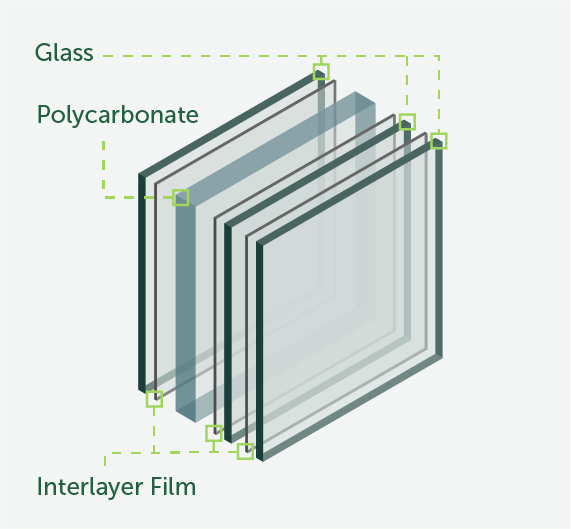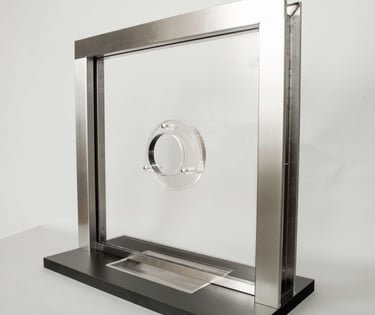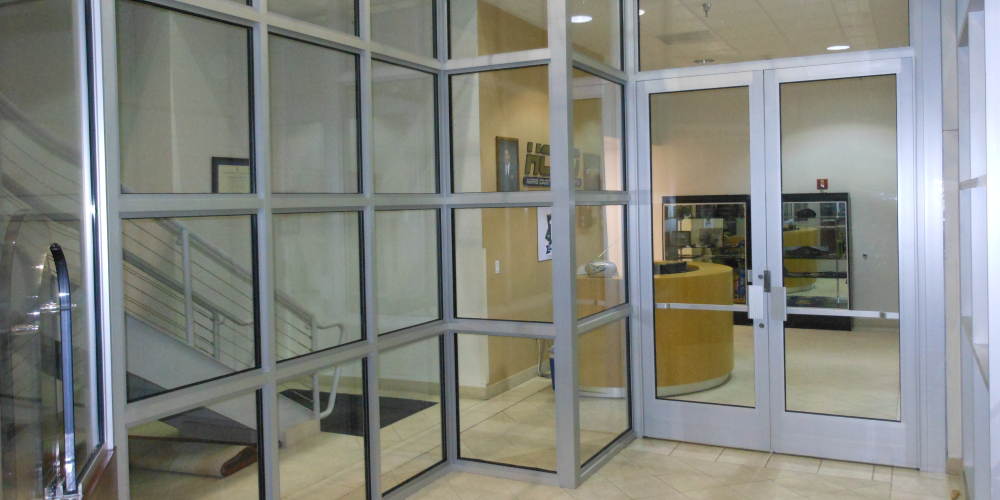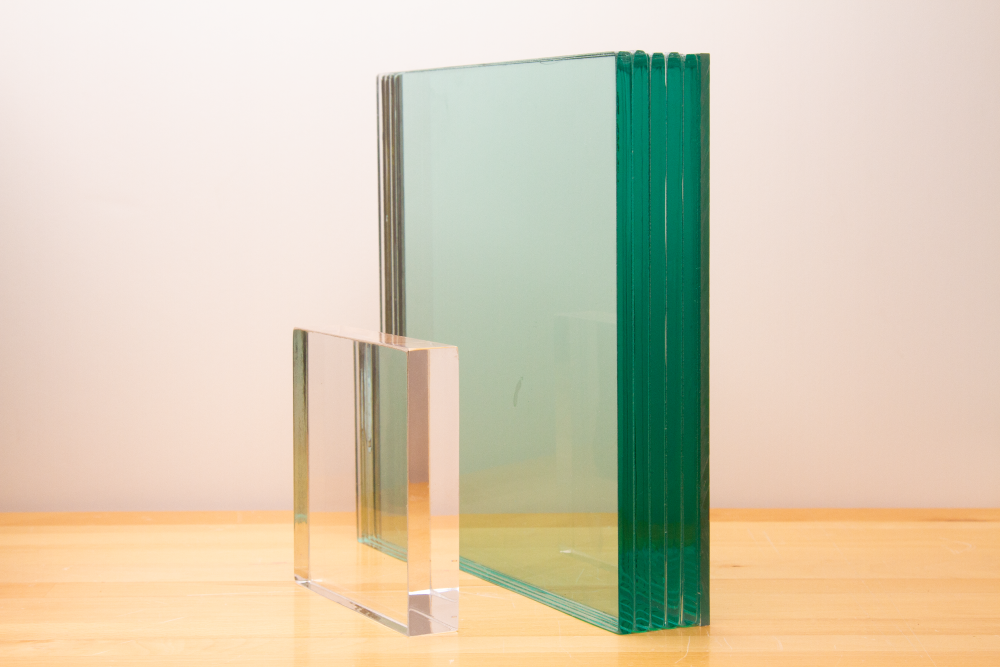Over the last several years, the demand for ballistic glazing has surged. The diversity of products on offer has likewise expanded, not just in terms of security performance, but also aesthetically. Bulletproof tint glass—previously a rarity—is now available in nearly as many varieties as any other commercial glass.
But, as is always the case, having more options leaves more room for misunderstandings. Here’s what you should know about tint and other visual variations in bulletproof glass so you can ensure your next project looks exactly how you envisioned it.
It’s Normal For Some Glass To Look “Tinted”
Technically, "tint" refers to an extra film, coating, or interlayer added to a glass pane during production with the goal of imparting color to the glass, or otherwise reducing light transmission. Tinted car windows are a classic example: this is a dark film applied to the inside of the car windows.
People also use the word "tint" when they talk about certain types of glass transmitting or reflecting light with slight variations. For example, everyone is familiar with standard float glass used in the windows of most public buildings and will recognize its slightly green "tint." This is especially obvious along the cut edges of the glass or when the glass is viewed at an angle under certain lighting conditions. Meanwhile, you almost never see this green on the edges of eyeglass lenses or drinking glasses.
But this green isn’t actually “tint”; what you're seeing is the true color of that glass. (It's caused by trace amounts of iron oxide naturally present in the raw silica sand used to make glass, which also imparts strength). Eyeglass lenses, on the other hand, are almost always made of polycarbonate, which lacks iron oxide, and thus doesn't have those trace colors. Drinking glasses, on the other hand, are often made from low-iron glass—which likewise lacks the iron oxide that imparts that greenish tone.
Understanding Bulletproof Tint Glass
At one time, when most builders relied on straight acrylic or polycarbonate for their ballistic glazing, bulletproof tint windows were rare. But in recent years, more builders have begun using glass-clad polycarbonate (GCP). This is an extremely versatile laminated ballistic transparency. It is made up of layers of glass, polycarbonate, acrylic, and other materials with optional custom interlayers and combinations. As such, GCP offers many bulletproof tint options and other variations to enhance window performance while also enhancing security.
As Total Security Solutions project manager Tom Zink explains, "I’m sitting by the window right now, and it’s fine. But in this same spot after 12 o'clock, it's just baking me. With conventional glass, you've always had plenty of options, in terms of adding coatings and tints to control how much heat is transmitted. Until just a few years ago, it was a big deal for someone to bump up to plain old Level 3 low-spall GCP ballistic glazing for an exterior window. Because the demand was limited, there wasn't a lot of room in the market to offer many options.”
With demand skyrocketing, glassmakers are offering many more options.. “Today,” Tom adds, “you could spec ballistic glass with better performance for heat efficiency and heat gain. You can put a low-E coating onto the glass to would help reflect or absorb that energy. Or you have many more aesthetic options like tints, colors, mirroring, or frosted interlayers."
But that doesn't mean all "clear glass” (glass with no tinted coating or interlayer) is going to be perfectly optically clear. Just like a commercial show window, pint glass, or eyeglasses lens, each type of ballistic glazing—and even different makeups of the same type of glazing—can and will have unique visual characteristics.

Small Details Can Have a Big Visual Impact
TSS recently worked on a project where these issues came to the forefront.
The end-user envisioned an impressive “floating wall” entrance: a long unbroken window wall with an unobtrusive doorway in the middle. This entryway needed some bullet resistance and a forced-entry rating.
To accomplish this, the architect designed a wall entirely composed of four-foot by six-foot panes of Level 3 low-spall GCP. The central pair of "windows" would be fabricated to function as a set of double doors. The architect and end users selected unique door hardware for this doorway, which required notching those two panes of ballistic GCP (rather than cutting round holes, as is the case with many styles of door hardware).
When the GCP arrived, the end-user noted the tints were slightly different—which was perplexing, because none of the pieces were supposed to have been tinted at all.
After some investigating, TSS determined tint was not the issue at all. Instead, the architect and building owners were seeing the GCP reflecting slightly different tones in certain light. The "window" sections of the wall had a green tone, while the "door" sections had a slightly purple hue. This was because their architect had specified square cuts for the door hardware, instead of round holes. That one seemingly minute detail (to the architect and end-user) had much larger ramifications down the road.
Understanding Your Vision So We Can Help Realize It
GCP, in contrast to some other ballistic glazing, can only be cut on a water jet cutter. (This is a consequence of the makeup of the GCP, which gives it ballistic strength, forced-entry resistance, and enhanced all-weather durability.)
As Tom Zink explains, "If you want a hole in the middle of a standard piece of GCP, for something like a hole and backer voice port," shown below, "that's not a problem. But when you have to cut in from the edge and do 90-degree corners, the GCP becomes more fragile and prone to cracking.”

That’s not to say 90-degree cuts are impossible in GCP. The GCP makeup just needs to be shifted slightly to use a different interior layer, altering how it performs under the strains of those sharp angled cuts. This interlayer has very slight different optical characteristics. Under normal circumstances, where pieces of transparency are separated by a section of wall or thick ballistic framing, it's likely no one would ever notice. But where different makeups of GCP are butted up against each other, the contrast (although subtle) is much more noticeable.
"Increasingly, this is what we're running into now. Somebody who's looking at a computer or looking up specs has a specific vision. But that vision doesn't always get communicated to us. If they run with it and just send us a cut sheet or list of materials, it’s too late. We always prefer being brought into the design process as soon as possible. That way we can listen to what the customer is trying to accomplish and send them samples to make sure the product lines up with the vision.”
"Digging Deeper" to Avoid Bulletproof Tint Headaches and Heartbreaks
"I don't want to say 'There's Never a No'," Tom says. TSS has decades of experience taking on challenging custom projects. "But there are almost always options—if we get the opportunity to offer those options."
If a design team reaches out to TSS early on, we can explain some of the trade-offs and find a solution that works for everyone. Unfortunately, some projects are structured like a game of telephone: a client talks to an architect, who talks to the general contractor, who brings in a glazer, who calls someone like TSS to supply the glass.
"Sometimes we hear from a contractor or glazer who only knows the materials they’ve been asked to get. They don’t have a view of the big picture. We’d much rather get on a phone call with everyone so we can understand the goal and present the best possible solution.”

Make the Most of Your Experts and Their Expertise
Tom points out, "You hire us to be the experts, not to be an order taker. That pays off big time when you get on a call with us to talk through your design.” TSS is always here to fill in those gaps and make sure every customer understands the pros, cons, and ramifications of every material they select and design they pursue.
Have questions? Ready to get started with a custom ballistic barrier project? Contact our ballistic security experts whenever you're ready or download our new Ballistic Glazing Solutions Guide.

